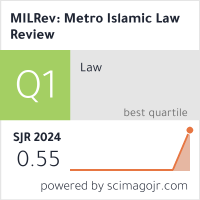Transformation of Contemporary Fiqh through a Collective Ijtihad Approach in Resolving Lineage Issues Arising from Egg Freezing
DOI:
https://doi.org/10.32332/milrev.v4i2.10403Keywords:
Collective Ijtihad, Contemporary Fiqh, Egg Freezing, Islamic Law, Kinship Lineage.Abstract
Egg freezing has triggered scholarly debate in Islamic jurisprudence, particularly when eggs are frozen before marriage and used afterward, raising concerns about the child's lineage. Contemporary fiqh through collective ijtihad is needed to offer solutions aligned with maqasid al-shariah. This research aims to analyze the formulation of contemporary fiqh in determining the legal ruling on egg freezing through a collective ijtihad framework. The study adopts a qualitative approach with a normative-empirical method. Data were collected through a literature review of classical fiqh texts, academic journals, and scholarly fatwas, followed by a descriptive-qualitative analysis. The findings of this study indicate that the formulation of contemporary Islamic jurisprudence through the collective ijtihad approach serves as an effective method for resolving lineage-related issues arising from egg freezing. The first step in the collective ijtihad process involves considering input from medical experts, beginning with a detailed presentation of the procedures, including ovarian stimulation, followed by the retrieval of mature oocytes, which are then cryopreserved using vitrification techniques to ensure optimal quality for long-term storage. Subsequently, Islamic jurists analyze and deliberate on the issue from various jurisprudential perspectives. Egg freezing is considered permissible as long as it is conducted within the framework of lawful marriage and upholds the principle of hifz al-nasl (protection of lineage). This study contributes to the advancement of Islamic legal thought that is responsive to the developments in reproductive technologies.
Downloads
References
Al-Jaziry, ’Abd Ar-Rahman. Al-Fiqh ’Ala Al-Madzhab Al-Arba’ah. Al-Qahirah: Dar Al-Hadith, 2004.
Andi Moh Rezki Darma, by, Achmad Musyahid, Samsidar Jamaluddin, and Andi Moh Rezki Darma. “Al-Maqqahid Al-Shari’ah Philosophical Aspects And Its Relevance To Contemporary Ijtihad.” International Journal of Social Science 2, no. 4 (December 5, 2022): 1923–1928. https://doi.org/10.53625/IJSS.V2I4.4179.
Ansori, Ansori. “Rekonstruksi Metodologi Fikih Kontemporer.” Al-Manahij: Jurnal Kajian Hukum Islam 12, no. 2 (December 5, 2018): 329–340. https://doi.org/10.24090/MNH.V12I2.1302.
Aslati, Armi Agustar, Silawati, Arisman, and Siti Arafah. “Utilizing Science and Maqasid Al-Shari’ah in Resolving Contemporary Issues of Islamic Family Law.” Al-Manahij: Jurnal Kajian Hukum Islam 18, no. 1 (March 16, 2024): 17–36. https://doi.org/10.24090/MNH.V18I1.10571.
Asni, Asni, Ashadi L. Diab, Kartini Kartini, and Kamarudddin Kamarudddin. “The Urgency of Transdisciplinary Approaches in Contemporary Islamic Law Studies.” KnE Social Sciences 7, no. 8 (April 8, 2022): 615–622. https://doi.org/10.18502/KSS.V7I8.10779.
Az-Zuhaily, Wahbah. Fiqh Al-Islam Wa Adilatuh. Beirut: Al-Maktabah, 1994.
Bahrudin, Moh., Tulus Suryanto, and Mohd Mizan bin Mohammad Aslam. “The Implementation of Ijtihad Jama’iy in MUI’s Fatwa Commission.” Walisongo: Jurnal Penelitian Sosial Keagamaan 28, no. 2 (November 30, 2020): 125–144. https://doi.org/10.21580/WS.28.2.6293.
Bahrudin, Moh, Tulus Suryanto, Mohd Mizan, and Mohammad Aslam. “The Implementation of Ijtihad Jama’iy in MUI’s Fatwa Commission.” Walisongo: Jurnal Penelitian Sosial Keagamaan 28, no. 2 (November 30, 2020): 125–144. https://doi.org/10.21580/WS.28.2.6293.
Barrett, Francesca, Jacquelyn Shaw, Jennifer K. Blakemore, and Mary Elizabeth Fino. “Fertility Preservation for Adolescent and Young Adult Transmen: A Case Series and Insights on Oocyte Cryopreservation.” Frontiers in Endocrinology 13 (May 24, 2022). https://doi.org/10.3389/FENDO.2022.873508.
Bisri, Hasan. “Hukum Islam Dan Perubahan Sosial: Telaah Atas Ijtihâd Fardi Dan Jamâ’i.” TAJDID 26, no. 2 (October 12, 2019): 187. https://doi.org/10.36667/TAJDID.V26I2.314.
Bouzenita, Anke Iman, and Feryad A. Hussain. “Psychological and Societal Impacts of Unknown Descent and The Islamic Objective of Nasab. A Preliminary Study of Chosen Biomedical Technologies.” IIUM Medical Journal Malaysia 20, no. 1 (January 1, 2021): 171–186. https://doi.org/10.31436/IMJM.V20I1.1767.
Budiariati, Vista, Safira Damayanti, and Shafara Widyanti Lukmana. “Komparasi Oosit Dan Histologi Ovarium Mencit Dengan Superovulasi Hormonal Dan Kombinasi Induksi Ovulasi.” BIOTIKA Jurnal Ilmiah Biologi 21, no. 1 (June 22, 2023): 45–50. https://doi.org/10.24198/BIOTIKA.V21I1.44821.
Engelcke, Dörthe, and Nadjma Yassari. “Child Law In Muslim Jurisdictions: The Role Of The State In Establishing Filiation (Nasab) And Protecting Parentless Children.” Journal of Law and Religion 34, no. 3 (December 1, 2019): 332–335. https://doi.org/10.1017/JLR.2019.40.
Gayete-Lafuente, Sonia, Volkan Turan, and Kutluk H. Oktay. “Oocyte Cryopreservation with in Vitro Maturation for Fertility Preservation in Girls at Risk for Ovarian Insufficiency.” Journal of Assisted Reproduction and Genetics 40, no. 12 (December 1, 2023): 2777–2785. https://doi.org/10.1007/S10815-023-02932-7.
Giannopapa, Maria, Anna Sakellaridi, Anastasia Pana, and Venetia Sofia Velonaki. “Women Electing Oocyte Cryopreservation: Characteristics, Information Sources, and Oocyte Disposition: A Systematic Review.” Journal of Midwifery & Women’s Health 67, no. 2 (March 1, 2022): 178–201. https://doi.org/10.1111/JMWH.13332.
Hipni Universitas Islam Negeri Sulthan Thaha Saifuddin Jambi Jl Raya Jambi -Muara Bulian, Darul KM, Simpang Sungai Duren Jambi Luar Kota, Muaro Jambi, and Anwar M Radiamoda. “The Importance of the Ijtihad Jama’i Method in Contemporary Fiqh Formulations.” Al-Risalah: Forum Kajian Hukum Dan Sosial Kemasyarakatan 23, no. 1 (June 16, 2023): 13–20. https://doi.org/10.30631/ALRISALAH.V23I1.1322.
Hukum, Fakultas, Universitas Muhammadiyah Surakarta, Jln A Yani, Tromol Pos, Pabelan Kartasura, Aidul Fitriciada Azhari, M Mu’inudinillah Basri, and Fatkhul Muin. “Transformation Of Maqâshid Al-Syarî’ah (An Overview of the Development of Islamic Law in Indonesia).” AL-IHKAM: Jurnal Hukum & Pranata Sosial 11, no. 1 (July 3, 2016): 1–18. https://doi.org/10.19105/AL-LHKAM.V11I1.854.
Husni, Syukriya, Fadilla Syahriani, Alfi Husni, Annisa Wahid, and Valensius Ngardi. “Determination of Nasab of Children Outside of Marriage in the Islamic Legal System: The Role and Decisions of Religious Courts in Indonesia.” Hakamain: Journal of Sharia and Law Studies 3, no. 1 (July 10, 2024): 26–36. https://doi.org/10.57255/HAKAMAIN.V3I1.332.
Ishaq, Ishaq, and Muannif Ridwan. “A Study of Umar Bin Khatab’s Ijtihad in an Effort to Formulate Islamic Law Reform.” Cogent Social Sciences 9, no. 2 (December 15, 2023). https://doi.org/10.1080/23311886.2023.2265522.
J. David Creswell John W. Creswell. Research Design, 6th Ed. California: Sage Publication, 2022.
Jamaludin, Mohd Hafiz, Ahmad Hidayat Buang, and Arip Purkon. “Talfiq as A Method for Legal Solutions in Contemporary Islamic Law.” Ahkam: Jurnal Ilmu Syariah 24, no. 1 (2024): 55–66. https://doi.org/10.15408/AJIS.V24I1.33608.
Kakkar, Pragati, Joanna Geary, Tania Stockburger, Aida Kaffel, Julia Kopeika, and Tarek El-Toukhy. “Outcomes of Social Egg Freezing: A Cohort Study and a Comprehensive Literature Review.” Journal of Clinical Medicine 12, no. 13 (July 1, 2023). https://doi.org/10.3390/JCM12134182.
Kanan, Pensyarah, Fakulti Syariah, and Dan Undang-Undang. “Pendekatan Ijtihad Jama‘I Dalam Pengharmonisasian Ikhtilaf Fuqaha.” Journal of Fatwa Management and Research 12, no. 1 (July 9, 2018): 22–36. https://doi.org/10.33102/JFATWA.VOL12NO1.4.
Katsani, Dimitra, Nefeli Paraschou, Eleni Panagouli, Ermioni Tsarna, Theodoros N. Sergentanis, Nikolaos Vlahos, and Artemis Tsitsika. “Social Egg Freezing—A Trend or Modern Reality?” Journal of Clinical Medicine 13, no. 2 (2024): 1–11. https://doi.org/10.3390/jcm13020390.
Khan, Shiraz. “Collective Ijtihad: Regulating Fatwa in Postnormal Times: (By Hossam Sabry Othman).” American Journal of Islam and Society 41, no. 3–4 (December 23, 2024): 102–107. https://doi.org/10.35632/AJIS.V41I3-4.3561.
Makhlouf, Ahmed Gad. “Evolution of Islamic Law in the 20th Century: The Conception of Collective Ijtihad in the Debate Between Muslim Scholars.” Oxford Journal of Law and Religion 9, no. 1 (February 1, 2020): 157–178. https://doi.org/10.1093/OJLR/RWAA019.
Ma’mun, Solihul Aminal, Uin Sunan, and Kalijaga Yogyakarta. “Mentarjih Penetapan Nasab Anak Zina Kepada Ayah Biologis Berdasarkan Konsep Anak Dan Maqsad Hifz Al-Nasl.” Al-Maslahah : Jurnal Ilmu Syariah 16, no. 2 (February 15, 2020): 198–215. https://doi.org/10.24260/AL-MASLAHAH.V16I2.1596.
Mintziori, Gesthimani, Stavroula Veneti, Efstratios M. Kolibianakis, Grigorios F. Grimbizis, and Dimitrios G. Goulis. “Egg Freezing and Late Motherhood.” Maturitas 125 (July 1, 2019): 1–4. https://doi.org/10.1016/J.MATURITAS.2019.03.017.
Nufus, Ahmad Fauzan, and Ilma Silmi. “The Problems of Neuroparenting Based on Contemporary Islamic Family Law.” MILRev: Metro Islamic Law Review 3, no. 2 (December 11, 2024): 198–216. https://doi.org/10.32332/MILREV.V3I2.9791.
Nur, Iffatin, Syahrul Adam, and M. Ngizzul Muttaqien. “Maqasid Al-Shari‘at: The Main Reference and Ethical-Spiritual Foundation for the Dynamization Process of Islamic Law.” Ahkam: Jurnal Ilmu Syariah 20, no. 2 (2020): 331–360. https://doi.org/10.15408/AJIS.V20I2.18333.
Pérez-Hernández, Yolinliztli, and Michiel De Proost. “Egg Freezing, Genetic Relatedness, and Motherhood: A Binational Empirical Bioethical Investigation of Women’s Views.” Bioethics 38, no. 7 (September 1, 2024): 592–599. https://doi.org/10.1111/BIOE.13163.
Permatasari, Annisa. “Elasticity of Islamic Law in Social Dynamics (Analysis of E-Comerce A Fiqh Perspective).” MILRev: Metro Islamic Law Review 1, no. 1 (December 26, 2022): 34–53. https://doi.org/10.32332/MILREV.V1I1.6189.
Piwko, Aldona. “Contemporary Islamic Law between Tradition and Challenges of Modernity: Some Examples Worth Consideration.” Bogoslovni Vestnik 81, no. 1 (2021): 91–101. https://doi.org/10.34291/BV2021/01/PIWKO.
Purkon, Arip. “Rethinking of Contemporary Islamic Law Methodology: Critical Study of Muhammad Shahrur’s Thinking on Islamic Law Sources.” HTS Teologiese Studies / Theological Studies 78, no. 4 (March 16, 2022): 7. https://doi.org/10.4102/HTS.V78I4.7152.
Puspitasari, Herien. Metode Penelitian Keluarga Edisi Revisi. Bogor: IPB Press, 2018.
Putra, Restu Ashari, Reza Pahlevi Dalimunthe, and Rizal Abdul Gani. “Konsep Perlindungan Nasab Dalam Perspektif Hukum Islam.” Mutawasith: Jurnal Hukum Islam 4, no. 1 (July 12, 2021): 32–41. https://doi.org/10.47971/MJHI.V4I1.304.
Rimon-Zarfaty, Nitzan, Johanna Kostenzer, Lisa Katharina Sismuth, and Antoinette de Bont. “Between ‘Medical’ and ‘Social’ Egg Freezing : A Comparative Analysis of Regulatory Frameworks in Austria, Germany, Israel, and the Netherlands.” Journal of Bioethical Inquiry 18, no. 4 (December 1, 2021): 683–699. https://doi.org/10.1007/S11673-021-10133-Z.
Rizkiyana, Firzza Shafira. “Tinjauan Maqashid Syariah Tentang Pembekuan Sel Telur Manusia (Egg Freezing).” Jurnal Riset Hukum Keluarga Islam, July 30, 2023, 29–34. https://doi.org/10.29313/JRHKI.VI.1938.
Rohmawati, Rohmawati, and Ahmad Rofiq. “Legal Reasonings of Religious Court Judges in Deciding the Origin of Children: A Study on the Protection of Biological Children’s Civil Rights.” Ijtihad : Jurnal Wacana Hukum Islam Dan Kemanusiaan 21, no. 1 (June 30, 2021): 1–20. https://doi.org/10.18326/IJTIHAD.V21I1.1-20.
Song, Bonnie B., and Molly M. Quinn. “Planned Oocyte Cryopreservation: A Review of Current Evidence on Outcomes, Safety and Risks.” Obstetrics and Gynecology Clinics of North America 50, no. 4 (December 1, 2023): 707–719. https://doi.org/10.1016/j.ogc.2023.08.005.
Taufiqurohman, and Nelli Fauziah. “The Evaluation of Maqasid Asy-Syari’ah on Discourses of the Islamic Family Law.” El-Usrah: Jurnal Hukum Keluarga 6, no. 1 (September 26, 2023): 81–90. https://doi.org/10.22373/UJHK.V6I1.13035.
Uin, Agustin Hanapi, Ar Raniry, Banda Aceh, Imanuddin Uin, Ar Raniry Banda, Aceh Khairuddin, and Hasballah Uin. “Kedudukan Metode Al-Qafah Dalam Penetapan Nasab Anak Menurut Ulama Perspektif Maqashid al-Syariah.” De Jure: Jurnal Hukum Dan Syar’iah 14, no. 1 (June 29, 2022): 21–37. https://doi.org/10.18860/J-FSH.V14I1.15875.
“View of Health Law in Islam (Study of Law About Organ Transplant Accoring to Fiqh).” Accessed April 19, 2025. https://e-journal.metrouniv.ac.id/milrev/article/view/6196/3040.
Zuhdi, Muhammad Harfin, and Mohamad Abdun Nasir. “Al-Mashlahah and Reinterpretation of Islamic Law in Contemporary Context.” Samarah: Jurnal Hukum Keluarga Dan Hukum Islam 8, no. 3 (October 17, 2024): 1818–1839. https://doi.org/10.22373/SJHK.V8I3.24918.
Downloads
Published
Issue
Section
License
Copyright (c) 2025 Edi Susilo, Budi Santoso, Yessy Eka Ambarwati

This work is licensed under a Creative Commons Attribution-ShareAlike 4.0 International License.










